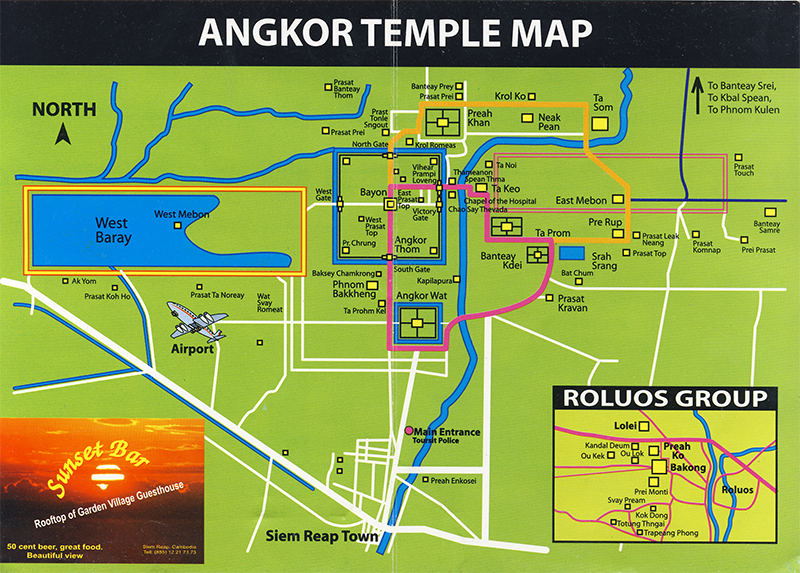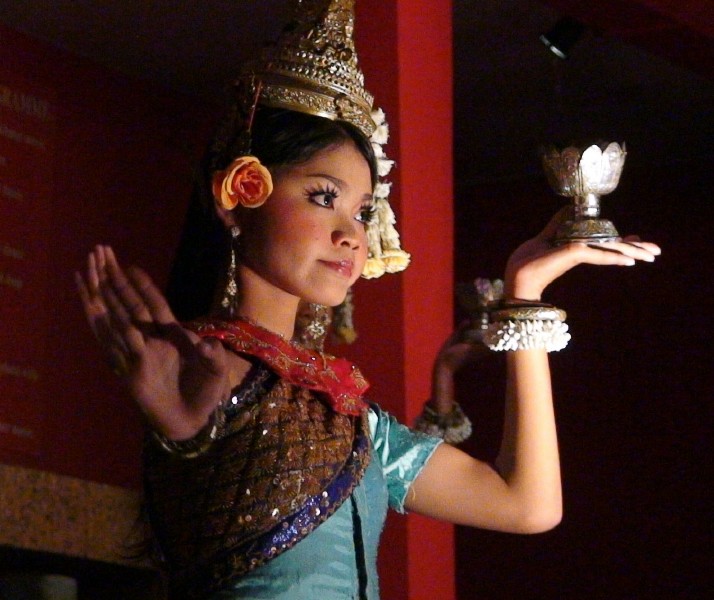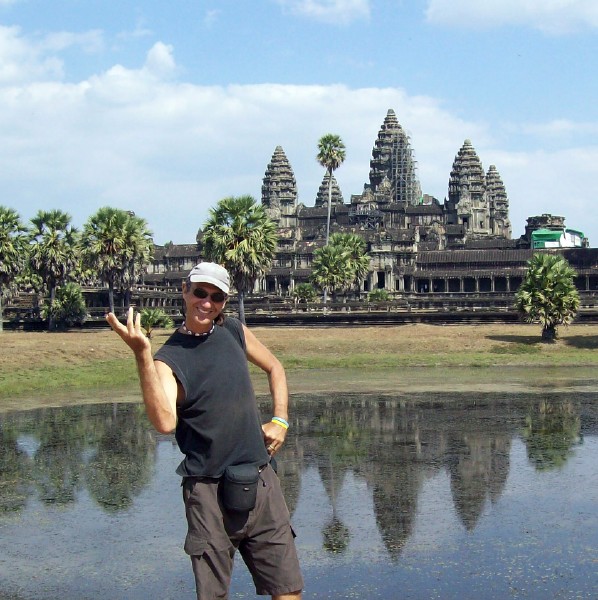In this post I will outline how to cycle Angkor Wat, Siam Reap, Cambodia. I provide details that include maps, costs, logistical requirements and facts as well as links to additional details, photos and videos. This is a self-guided adventure on a shoestring. Follow the links to dig deeper into the adventure.
Difficulty Level:
 A week of bicycling in the sun to see as much of Angkor Wat as possible?
A week of bicycling in the sun to see as much of Angkor Wat as possible?
Yes, possible but not cheap.
Total Cost Range of this Activity is: $$
![]()
Details:
| 7 Nights in Siem Reap GH w/o hot water 7 day bicycle rental Angkor Wat 1 week pass ($20=1 day, $40=3 day) Meals (7 days) Tuk-Tuk to remote temples |
$45 $10 $60 $140 $25 |
| Total | $280 |
2009 prices
Angkor Small Site Map

Angkor Site Map

Timeline of Angkor

Map of Sien Reap Town

Accommodation (lots of alternatives):
I stayed at the Home Sweet Home GH in a spacious $6 per night room (w/o hot water). Note that Cambodia uses the US dollar and only really uses its local currency for amounts less than $1. Even the ATMs (cash machines) disburse US dollars.
Click to watch Video
Angkor Wat Photos
The Narrative
Visiting Angkor Wat (via the Cambodian city of Siem Reap) wasn’t really an option for two good reasons. Firstly, a few years ago I had read an adventure story about the guy who discovered it and became fascinated by the idea of visiting a vast complex of ancient ruins that were still relatively un-commercialized (although the clock was ticking). Secondly, it turned up on so many people’s contributions to my Bucket List email last year. So when I ventured into SE Asia I naturally included Cambodia and Angkor Wat as destinations, however, at the time I didn’t really think that it was worthy of ‘adventure’ status on my web site (even though I have been including a lot of really easy or package-types stuff lately, but how tough could it be to visit a bunch of ruins?). Yet by the end of my first day of walking around Angkor Wat I knew I was in for more than I had bargained for. I hadn’t known that Angkor Wat is actually only one of many temple complexes scattered around Siem Reap and far beyond.
On my first day I simply rented a bicycle from my guesthouse and set off up the main road with a tiny fold-out map. I opted for the bike because I wanted to get a feel for the scale of the place before I committed to one of the many tuk-tuk (moto-romauk) drivers who were constantly pitching $20-day (and up) transport options. I wanted a little freedom, even though they swore that I would get lost without their comprehensive experience.
At the main ticket entrance I purchased a $60 one-week pass (options include a $20 one-day or $40 three-day pass) and cycled north following the other cycling tourists and the constant flow of tuk-tuks. There is no way I could have missed Angkor Wat. I just needed to follow the flow until reaching the yelling cycle parking, drinks, post cards, flutes, books, and food touts fighting for each visitor’s attention at the entrance of each major complex. I parked and locked my bike under a tree and walked to the long stone causeway that leads to the outer wall. There I was asked to show my ticket (very politely) and then I continued onward with the crowd until I had crossed the lake and reached the outer wall. Here I cut to the left (leaving the herd) and walked thru one of the smaller entrances. I was immediately intrigued by the large stone Buddha that sat in the middle of the passageway. To either side, stone corridors stretched out as far as the eye could see. Apparently the entire outer wall is hollow and filled with archways, carvings, and statues (both inside and outside). Yet when I exited the arch and into the inner courtyard I discovered that the major Angkor Watt temples and buildings were far off in the distance and these archways and carvings are just the appetizer. The complex was huge, with smaller temples littering the area in between, as did two picturesque lakes.

It was an extremely hot and sunny day (as they all are in the dry season) and I was already soaked with perspiration and feeling a bit thirsty, as I continued on across the dry open expanse, then circling to the left (again to avoid the main flow of the herd and to find an angle where the restoration scaffolding would be obscured from my photos). After a long walk I reached a shaded forest that ran around three sides of the inner complex. There I rested and started to film and take photos.
At this stage I will skip the rest of the day’s photo/filming details, and simply say that the day was an absolute scorcher, that Angkor Wat was overwhelming, that the carvings are continuous (four even cover the entire hallway walls of the inner boundary square), the scale is huge, you can pretty much walk on any ledge, up any ridiculously steep flight of ancient broken and cracked stone stairs, and into any structure to your heart’s content.
By 5pm I was spent and sun bleached. I peddled back to my guesthouse and wondered how I would possibly visit any number of the other even larger temple complexes that are tightly clustered in three main groupings within a 30 km range (not to mention the ones outside of this main area).
That evening Cristina said I was crazy to buy a 7-day pass that she would buy the 3-day pass, and it should be more than enough time for her to see what she wanted to see based on a Cambodia guidebook she had purchased that day.
The next morning we both rented bikes from the guesthouse and set off to repeat part of my previous day’s journey. We stopped at the ticket office so she could purchase her pass and then spent the morning at Angkor Watt. By lunchtime she was exhausted and had changed her assessment. She felt that it would be impossible for her to even cover half of what she wanted to see in three days and that she should have gotten a 7-day pass.
We then cycled north to enter the Angkor Thom complex via the south gate. It was even more astounding than Angkor Wat in some ways. The bridge leading to the gate is flanked by a long line of double life-size stone soldiers. Each one was fascinating, but what can you say about a long line of them that is over 100 m long, and on both sides of the road leading to a huge wall that encloses an area much larger than Angkor Wat? The entrance is topped by 3m high stone faces that point in the four directions of the compass. Cristina informed me that these large stone faces are the repeating theme of Angkor Thom and all its structures. We then rode on past numerous smaller roadside temples, ruins, and structures until we reached a large central complex called Bayon.
Before tackling Bayon we accepted a lunch offer from one of the woman chasing us and waving menus. We agreed on two Pepsi drinks for the price of one (2 for $1) and then sat down to eat stir-fry while little children entertained us with offers of post cards, flutes, and nick-knacks.
After Pepsi, lunch, and one pack of post cards, we spent the remainder of the afternoon wandering around, in, up, and upon Bayon. I simply couldn’t get enough photos or video. Everywhere I looked I found more structures topped by large stone faces. By 4pm Cristina was exhausted and I was out of tapes and batteries, so we reclaimed our bikes and retraced our path back to the guesthouse.
The next day Cristina reluctantly agreed to a more aggressive agenda that would start by heading east at Angkor Wat, then north, then turn back to the east to continue north from just above the Bayon (our ending point the previous day) and then circled north, east, and then south in a 25km loop that would take in the entire East Baray loop (northeast section of complexes).
At least that was the plan, and we did follow it to some extent. We started by visiting Banteay Kdei, which was interesting, but crumbling due to the way the stones were laid, and then spent some time with a group of musicians that were landmine victims.
We then cycled to Ta Prohm which is not as large as some of the complexes, but unique because of the giant trees that have over-grown many of the walls and buildings. Here I got a sense of the size of the trees and the depth of the jungle that once hid the entire Angkor Wat complex. This is especially relevant because the countryside is now almost entirely cultivated or covered by new growth managed small forests. These ancient trees (many over 100m high and 5m wide at the base) stretch so far up into the sky are incomprehensible until you have seen them with your own eyes. No wonder the area kept its secrets for so long.
After Ta Prohm we rode back into Angkor Thom, via the east gate, returning to the main road above the Bayon. It was now around 2pm and we were tired and thirsty, but had hardly covered any of the planned ground. Reluctantly Cristina agreed to turn north and do the planned long north-east loop circuit, even though it would mean an additional 30 km of cycling.

We then rode, and rode, and rode some more. We stopped at a number of temples along the way and were Cristina obediently climbed up the long and high stairways to reach the tops, or rode her bike around them, or simply posed in front of them so that I could shoot some video or photos. This approach limited our visits and exploration, but did ensure that we reach our last objective of Pre Rup just before sunset.
At Pre Rup Cristina sluggishly ran up her last long flights of stone stairs for the day, and then we started the long stretch back to the guesthouse (another 13km). By the time we reached the room we were exhausted, dehydrated, and determined that the next day not involve bicycles.
The following day at breakfast we agreed on the far flung objectives of Kbal Spean and Banteay Srei. We selected these because they were both different from the other major complexes and because they were so far out of the area (42km each way) which ensured that we hire a tuk-tuk.
As we stepped out of our regular breakfast store/restaurant the next morning, we were assailed by the usual chorus of drivers fishing for customers, but in this instance we paid attention and started to haggle with one that seemed reasonable. He started by asking for a $20 fee we countered at $15 and eventually walked away. He ultimately accepted our offer but was not very happy with the negotiation. The other drivers said it was not a good price and that it wasn’t fair. I talked it over with our driver (John) and then I agreed to pay him his asking fare of $20 only if we felt the destinations were unreasonably far and if he treated us well. He brightened immediately and took on the mission with gusto.
We visited Kbal Spean first because it is further out of the area (on the mountain slopes far-far to the north) and closed early (2pm). It is not really a temple complex at all (as I had to explain to three Spanish tourists who asked me where the temple was while standing at the river’s edge). Kbal Spean is actually a bunch of carvings on river boulders or on the actual river’s stone bed. The intent was for the holy carvings to bless and sanctify the waters that flowed over them. In this way the water would be holy as it entered the administrative and worshiping temples downstream.
After the last carving along (or in) the river we cooled off by stepping into a handy waterfall. The water was not mountain cold as I had expected, but it was cool and as refreshing as any holy water I had ever bathed in.
We then started back to the parking area to wake up our trusty driver and head to Banteay Srey, which is a small temple complex in the middle of another lake/moat. This temple is also different from the norm in that it has the most intricate carvings on every surface. All of the temples at Angkor have carvings and designs on the walls, but they tend to be in the large to grand scale, while Banteay Srey is all about detail in comparison.
After Banteay Srey Cristina called it a day, even though our driver wanted to throw in a few more temples at no additional charge (the $5 promised mark-up did wonders for his attitude). I declined the offer and asked him to return us to our guesthouse and not to spare the horses. He drove us back at breakneck speed (which is not all that fast for a tuk-tuk, but much faster than the other tuk-tuks or the numerous bicycles crowding the narrow roads).
In spite of traffic jams in town, a flat tire earlier in the day, construction detours, and a long hot day, our driver kept smiling and remained up-beat. I handed over a $20 bill (plus $5 tip) when he let us of in front of our guesthouse, and he accepted with a smile that stretched from ear-to-ear. We were both happy. He had not simply gotten paid what he had originally demanded. He had gotten paid a bonus for a job well done and he felt as though he had earned it. We were happy with his services, the places we had selected to visit, and especially to be back at our guesthouse. So all in all it was a win-win day.
Angkor Wat Photos
Cambodia Border Crossing Details

